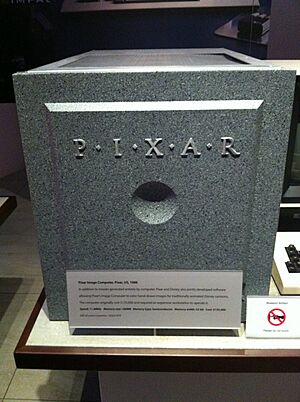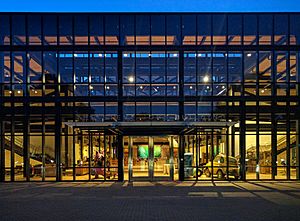Pixar facts for kids

Logo used since 1995
|
|
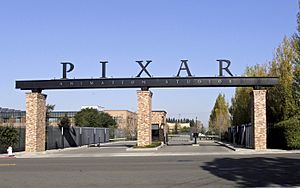
Headquarters in Emeryville, California
|
|
| Subsidiary | |
| Traded as | NASDAQ: PIXR (1995–2006) |
| Industry | Animation |
| Predecessor | The Graphics Group of Lucasfilm Computer Division (1979–1986) |
| Founded | February 3, 1986 in Richmond, California |
| Founders |
|
| Headquarters | 1200 Park Avenue,
,
U.S.
|
|
Area served
|
Worldwide |
|
Key people
|
|
| Products | Computer animations |
| Brands |
|
| Parent | Walt Disney Studios (2006–present) |
Pixar is an American animation studio located in Emeryville, California. It is famous for its amazing computer-animated movies that are loved by critics and audiences alike. Pixar is part of Walt Disney Studios, which is a big part of the Walt Disney Company.
Pixar began in 1979 as a small group within Lucasfilm's computer division. It was first called the Graphics Group. In 1986, it became its own company with help from Apple co-founder Steve Jobs. He became the main owner. In 2006, Disney bought Pixar. Pixar is well-known for its feature films, which are made using special software called RenderMan. The studio's fun mascot is Luxo Jr., a desk lamp from their 1986 short film.
Pixar has made 29 feature films. Their first film was Toy Story (1995), which was also the first movie ever made entirely with computers. Their most recent film was Elio (2025). The studio has also created many short films. By July 2023, Pixar's movies had earned over $15 billion worldwide. On average, each film made about $589 million.
Several Pixar films have earned over $1 billion. These include Toy Story 3 (2010), Finding Dory (2016), Incredibles 2 (2018), Toy Story 4 (2019), and Inside Out 2 (2024). These movies are among the top 50 highest-grossing films of all time. Also, 15 Pixar films are among the top 50 highest-grossing animated films ever. Inside Out 2 is currently the second highest-grossing animated film of all time.
Pixar has won many awards, including 23 Academy Awards, 10 Golden Globe Awards, and 11 Grammy Awards. Since 2001, eleven Pixar films have won the Academy Award for Best Animated Feature. These winners include Finding Nemo (2003), The Incredibles (2004), Ratatouille (2007), WALL-E (2008), Up (2009), Toy Story 3, Toy Story 4, Brave (2012), Inside Out (2015), Coco (2017), and Soul (2020). Toy Story 3 and Up were also nominated for the top award, Academy Award for Best Picture.
In 2009, some of Pixar's top leaders, like John Lasseter and Pete Docter, received a special award called the Golden Lion for Lifetime Achievement from the Venice Film Festival.
Contents
Pixar's Journey
How Pixar Started
Pixar's story began in 1974 at the New York Institute of Technology (NYIT). The founder, Alexander Schure, wanted to make the world's first computer-animated film. He hired computer scientists like Edwin Catmull and Alvy Ray Smith. They worked in a special lab and learned a lot about computer graphics.
The group later moved to Lucasfilm in 1979. There, they became the Graphics Group. They worked on new technologies for computer graphics, like special effects and animation tools. John Lasseter joined the team in 1983 and animated a short film called The Adventures of André & Wally B..
The name "Pixar" came about around this time. It was suggested as a catchy name for a new digital computer.
In 1982, the Pixar team started working on special effects for movies with Industrial Light & Magic. They created effects for films like Star Trek II: The Wrath of Khan. By 1986, the group became its own company, spun off from Lucasfilm. This happened because George Lucas was looking to sell parts of his company. The team wanted to stay together to achieve their dream of making a computer-animated movie.
At first, Pixar focused on selling special computer hardware called the Pixar Image Computer. This system was mainly sold to government, science, and medical groups.
Becoming an Independent Company (1986–1999)
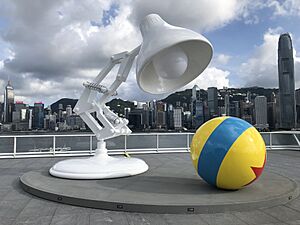
In 1986, Pixar became an independent company. Steve Jobs, who had left Apple, invested $10 million of his own money. He became the chairman of Pixar's board.
Pixar had a deal with Disney in 1986. Disney bought Pixar's Image Computer and software to help with their own animation process. This helped Disney make films like The Rescuers Down Under (1990) more efficiently.
To show what their computers could do, Pixar animator John Lasseter made short films like Luxo Jr. (1986). These shorts were very popular at computer graphics events.
However, the Image Computer did not sell well, and Pixar faced financial problems. Steve Jobs invested more money, eventually owning the whole company. In 1989, Lasseter's animation team started making computer-animated commercials for other companies. In 1990, Pixar sold its hardware division and moved to Richmond, California. They also started selling their software, like RenderMan, to others.
By 1991, Pixar had fewer employees. Steve Jobs became the full owner. A few months later, Pixar made a big deal with Disney to create three computer-animated feature films. The first of these was Toy Story (1995).
Even with these projects, Pixar was still losing money. Steve Jobs thought about selling the company. But after hearing that Toy Story would likely be a big hit, he decided to give Pixar another chance. He also became the CEO. Toy Story earned over $373 million worldwide. When Pixar offered its shares to the public in November 1995, it was a huge success.
After Toy Story was released, Pixar stopped making TV commercials in 1996 to focus on longer movies and interactive entertainment.
During the 1990s, Pixar developed a special way of working called the "Pixar Braintrust." This is where all the directors, writers, and artists help each other by giving honest feedback on their projects. This helps make sure every film is the best it can be.
Because Toy Story was so successful, Pixar built a new studio in Emeryville, California, which opened in 2000.
Working with Disney (1999–2006)
Pixar and Disney had some disagreements, especially about Toy Story 2. This film was originally planned to go straight to video, but it became a full movie released in theaters. Pixar wanted it to count as one of the three films in their deal with Disney, but Disney disagreed.
The two companies tried to make a new agreement for a long time but couldn't agree. Pixar wanted more control over their films and to keep more of the profits. Disney thought Pixar's demands were too much.
Disagreements between Steve Jobs and Disney's CEO, Michael Eisner, caused talks to stop in 2004. Steve Jobs said Pixar would look for other partners. However, Pixar did not sign deals with other companies. Negotiations started again after Eisner left Disney in 2005.
Becoming a Disney Company (2006–Present)
After many talks, Disney agreed to buy Pixar for about $7.4 billion in January 2006. The deal was completed in May 2006. This made Steve Jobs Disney's largest individual shareholder.
As part of the deal, John Lasseter became the Chief Creative Officer for both Pixar and Walt Disney Animation Studios. Edwin Catmull remained President of Pixar and also became President of Walt Disney Animation Studios. Steve Jobs joined Disney's board of directors.
Lasseter and Catmull made sure that Pixar would remain a separate company with its own unique way of working. They wanted to keep Pixar's special culture. The name "Pixar" was guaranteed to continue, and the studio stayed in Emeryville. Films made after the merger started to be branded "Disney•Pixar."
Jim Morris became the general manager of Pixar, overseeing the daily operations.
Lasseter and Catmull also helped Disney Animation adopt some of Pixar's successful creative methods, like the "Braintrust." They made sure each studio focused on its own projects to keep their unique identities strong.
Changes and New Films (2010–Present)
In 2010, Pixar opened Pixar Canada in Vancouver, Canada. This studio made seven short films based on Toy Story and Cars characters. However, it closed in 2013 so Pixar could focus its efforts at its main headquarters.
In 2014, Jim Morris became president of Pixar.
In 2017, John Lasseter took a break from his role. In 2018, he left Disney Animation and Pixar. Pete Docter became the new Chief Creative Officer of Pixar.
Incredibles 2 was released in June 2018 and broke records for animated films. It earned $1.2 billion worldwide. In October 2018, Edwin Catmull announced his retirement. In June 2019, Toy Story 4 was released, also earning over $1 billion and winning an Academy Award.
Pixar released Onward in March 2020. Due to the COVID-19 pandemic, the film did not do well in theaters and was released early on streaming services. Soul was also released directly on Disney+ in December 2020 and won an Academy Award. Luca and Turning Red were also released on Disney+ in 2021 and 2022.
Lightyear was Pixar's first movie back in theaters in June 2022. It did not perform as well as expected. In December 2022, Disney CEO Bob Iger said they would focus more on the Pixar brand. In June 2023, some employees were laid off.
Elemental was released in June 2023. It started slowly but became a success at the box office, earning over $400 million worldwide. In December 2023, it was announced that Soul, Turning Red, and Luca would be released in theaters in early 2024.
In May 2024, Pixar had some layoffs, affecting about 14% of its employees. This happened as the studio planned to focus more on movies for theaters rather than streaming series.
On June 14, 2024, Inside Out 2 was released and became a huge financial success. It broke many box office records, including being the fastest animated movie to reach $1 billion globally in just 17 days. It also became the highest-grossing Pixar film worldwide.
Pixar's Campus
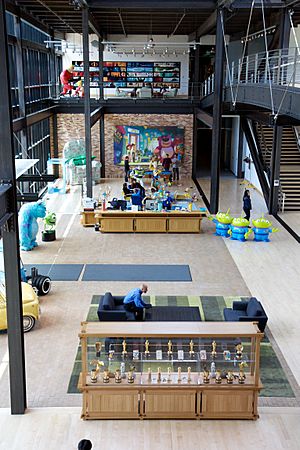
When Steve Jobs and John Lasseter decided to move Pixar to a bigger space, they chose a 20-acre site in Emeryville, California. The main building, designed by Bohlin Cywinski Jackson, is built to withstand earthquakes and has its own power generators. The design of the building reminds people of Emeryville's industrial past. It's a two-story building with many paths and spaces for people to work together.
In 2008, Pixar hosted the second Julia Robinson Mathematics Festival at their campus. This shows how important math is to their filmmaking process.
Pixar Films
Pixar Traditions
| 1995 | Toy Story |
|---|---|
| 1996 | |
| 1997 | |
| 1998 | A Bug's Life |
| 1999 | Toy Story 2 |
| 2000 | |
| 2001 | Monsters, Inc. |
| 2002 | |
| 2003 | Finding Nemo |
| 2004 | The Incredibles |
| 2005 | |
| 2006 | Cars |
| 2007 | Ratatouille |
| 2008 | WALL-E |
| 2009 | Up |
| 2010 | Toy Story 3 |
| 2011 | Cars 2 |
| 2012 | Brave |
| 2013 | Monsters University |
| 2014 | |
| 2015 | Inside Out |
| The Good Dinosaur | |
| 2016 | Finding Dory |
| 2017 | Cars 3 |
| Coco | |
| 2018 | Incredibles 2 |
| 2019 | Toy Story 4 |
| 2020 | Onward |
| Soul | |
| 2021 | Luca |
| 2022 | Turning Red |
| Lightyear | |
| 2023 | Elemental |
| 2024 | Inside Out 2 |
| 2025 | Elio |
| 2026 | Hoppers |
| Toy Story 5 | |
| 2027 | Gatto |
Many of Pixar's first animators came from traditional hand-drawn animation. Others were new college graduates or from computer animation backgrounds. The success of Toy Story (1995) made Pixar the first major computer-animation studio to successfully make movies for theaters.
Most of the animation industry is in Los Angeles, but Pixar is about 350 miles north in the San Francisco Bay Area. Pixar designed its animation software, Marionette, to be easy for traditional animators to learn.
Pixar films often share a theme of characters growing and learning to appreciate their friends and family. The main character's journey and how they change is always at the heart of the story.
Actor John Ratzenberger has voiced a character in almost every Pixar feature film from Toy Story through Onward (2020). A background character in Soul (2020) looks like him. Pixar even paid tribute to him in the end credits of Cars (2006) by showing car versions of his characters from other Pixar movies.
Fans have noticed many "Easter eggs" and connections between Pixar films. This led to "The Pixar Theory" in 2013, which suggests all Pixar characters live in the same universe.
Pixar films often have large budgets, usually between $150–200 million. This is partly because all their artists work together in the U.S., unlike some competitors who use international teams to save money.
Sequels and Prequels
As of March 2025, seven Pixar films have received or will receive sequels or prequels. These are Toy Story, Cars, Monsters, Inc., Finding Nemo, The Incredibles, Inside Out, and Coco.
Toy Story 2 was originally planned as a shorter, direct-to-video film. But the Pixar team decided to make it a full-length movie for theaters.
After Toy Story 2 in 1999, Pixar and Disney had an agreement that Disney would not make sequels without Pixar's help. However, when they couldn't agree on a new deal, Disney planned to make Toy Story 3 without Pixar. But after Disney bought Pixar in 2006, Toy Story 3 was brought back under Pixar's control and released in 2010.
Pixar's leaders have said they will make a sequel if they have a great story to tell. Cars 2 was released in 2011, and Monsters University, a prequel to Monsters, Inc., came out in 2013.
Finding Dory, a sequel to Finding Nemo, was released in 2016. Incredibles 2 and Cars 3 followed in 2018 and 2017. Toy Story 4 was released in 2019.
After Toy Story 4, Pixar's president, Jim Morris, said the studio might take a break from sequels to focus on original stories. However, Pixar's chief creative officer, Pete Docter, later mentioned that sequels are important for the studio's financial stability. In September 2022, Inside Out 2 was announced and released in June 2024. In February 2023, Disney CEO Bob Iger announced Toy Story 5 is in development for a 2026 release. In August 2024, Incredibles 3 was announced.
In March 2025, Coco 2 was announced to be in development.
TV Shows and Shorts
Toy Story was the first Pixar film to become a TV show, with Buzz Lightyear of Star Command. Cars also got its own short series called Cars Toons. Pixar has also released TV specials like Toy Story of Terror! (2013) and Toy Story That Time Forgot (2014).
Monsters at Work, a TV series based on Monsters, Inc., started in July 2021 on Disney+.
In December 2020, three more series were announced for Disney+. Dug Days, featuring Dug from Up, premiered in September 2021. Cars on the Road, following Mater and Lightning McQueen, premiered in September 2022. An original show called Win or Lose premiered in February 2025.
A TV series based on Inside Out, titled Dream Productions, premiered on Disney+ in December 2024.
Other Animation and Live-Action
Most Pixar films are fully computer-animated. WALL-E (2008) included a small amount of live-action footage. Some Pixar short films also feature 2D animation.
Pixar's creative leaders have also helped with other Disney films. They helped with the story for The Muppets (2011) and The Jungle Book (2016). Many Pixar animators also worked on a hand-drawn animation part for the 2018 film Mary Poppins Returns.
Pixar has also helped with the English versions of several films from the Japanese studio Studio Ghibli. In 2019, Pixar created a live-action hidden camera reality show for Disney+ called Pixar in Real Life.
Upcoming Films
Five new Pixar films have been announced. Hoppers, directed by Daniel Chong, is set for release on March 6, 2026. Toy Story 5, directed by Andrew Stanton, is scheduled for June 19, 2026. Gatto, directed by Enrico Casarosa, is planned for June 18, 2027. Also in development are Incredibles 3 and Coco 2.
Film Series
This list does not include the Cars spinoffs made by Disneytoon Studios.
| Titles | Films | Short films | TV seasons | Release Date |
|---|---|---|---|---|
| Toy Story | 6 | 7 | 4 | 1995–present |
| Monsters, Inc. | 2 | 2 | 2 | 2001–present |
| Finding Nemo | 2 | 4 | 0 | 2003–present |
| The Incredibles | 2 | 5 | 0 | 2004–present |
| Cars | 3 | 4 | 2 | 2006–present |
| Inside Out | 2 | 1 | 1 | 2015–present |
Top-Grossing Films
-
 Indicates films playing in theaters in the week commencing 26 December 2025.
Indicates films playing in theaters in the week commencing 26 December 2025.
| Rank | Title | Year | Gross |
|---|---|---|---|
| 1 | Inside Out 2 | 2024 | $652,980,194 |
| 2 | Incredibles 2 | 2018 | $608,581,744 |
| 3 | Finding Dory | 2016 | $486,295,561 |
| 4 | Toy Story 4 | 2019 | $434,038,008 |
| 5 | Toy Story 3 | 2010 | $415,004,880 |
| 6 | Finding Nemo‡ | 2003 | $380,843,261 |
| 7 | Inside Out | 2015 | $356,921,711 |
| 8 | Up | 2009 | $293,004,164 |
| 9 | Monsters University | 2013 | $268,492,764 |
| 10 | The Incredibles | 2004 | $261,441,092 |
| 11 | Monsters, Inc.‡ | 2001 | $255,873,250 |
| 12 | Toy Story 2‡ | 1999 | $245,852,179 |
| 13 | Cars | 2006 | $244,082,982 |
| 14 | Brave | 2012 | $237,283,207 |
| 15 | WALL-E | 2008 | $223,808,164 |
| 16 | Coco | 2017 | $210,460,015 |
| 17 | Ratatouille | 2007 | $206,445,654 |
| 18 | Toy Story‡ | 1995 | $191,796,233 |
| 19 | Cars 2 | 2011 | $191,452,396 |
| 20 | A Bug's Life | 1998 | $162,798,565 |
| 21 | Elemental | 2023 | $154,426,697 |
| 22 | Cars 3 | 2017 | $152,901,115 |
| 23 | The Good Dinosaur | 2015 | $123,087,120 |
| 24 | Lightyear | 2022 | $118,307,188 |
| 25 | Onward | 2020 | $61,555,145 |
| Rank | Title | Year | Gross |
|---|---|---|---|
| 1 | Inside Out 2 | 2024 | $1,698,863,816 |
| 2 | Incredibles 2 | 2018 | $1,243,225,667 |
| 3 | Toy Story 4 | 2019 | $1,073,394,593 |
| 4 | Toy Story 3 | 2010 | $1,066,969,703 |
| 5 | Finding Dory | 2016 | $1,028,570,889 |
| 6 | Finding Nemo‡ | 2003 | $941,637,960 |
| 7 | Inside Out | 2015 | $857,611,174 |
| 8 | Coco | 2017 | $807,816,196 |
| 9 | Monsters University | 2013 | $743,559,607 |
| 10 | Up | 2009 | $735,099,082 |
| 11 | The Incredibles | 2004 | $631,688,498 |
| 12 | Ratatouille | 2007 | $623,726,085 |
| 13 | Cars 2 | 2011 | $559,852,396 |
| 14 | Brave | 2012 | $538,983,207 |
| 15 | Monsters, Inc.‡ | 2001 | $528,773,250 |
| 16 | WALL-E | 2008 | $521,311,860 |
| 17 | Toy Story 2‡ | 1999 | $511,358,276 |
| 18 | Elemental | 2023 | $496,444,308 |
| 19 | Cars | 2006 | $461,983,149 |
| 20 | Toy Story‡ | 1995 | $394,436,586 |
| 21 | Cars 3 | 2017 | $383,930,656 |
| 22 | A Bug's Life | 1998 | $363,258,859 |
| 23 | The Good Dinosaur | 2015 | $332,207,671 |
| 24 | Lightyear | 2022 | $226,425,420 |
| 25 | Onward | 2020 | $141,940,042 |
‡—Includes theatrical reissue(s).
See also
 In Spanish: Pixar para niños
In Spanish: Pixar para niños
- The Walt Disney Company
- Walt Disney Animation Studios
- List of animation studios


